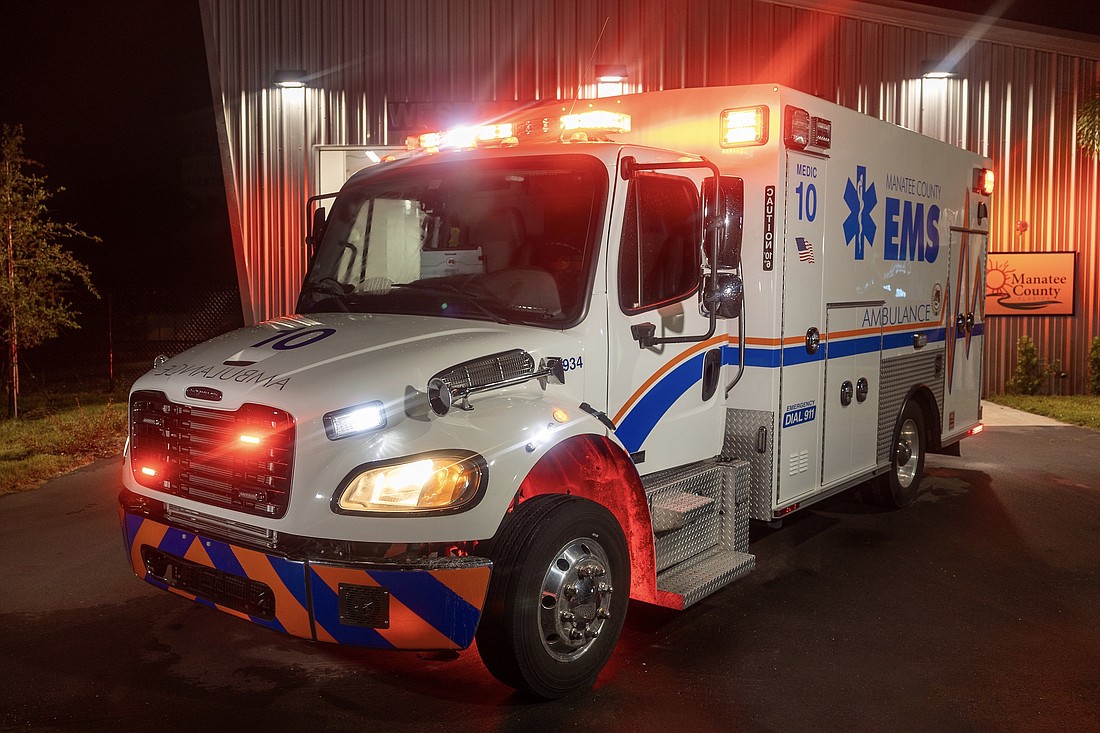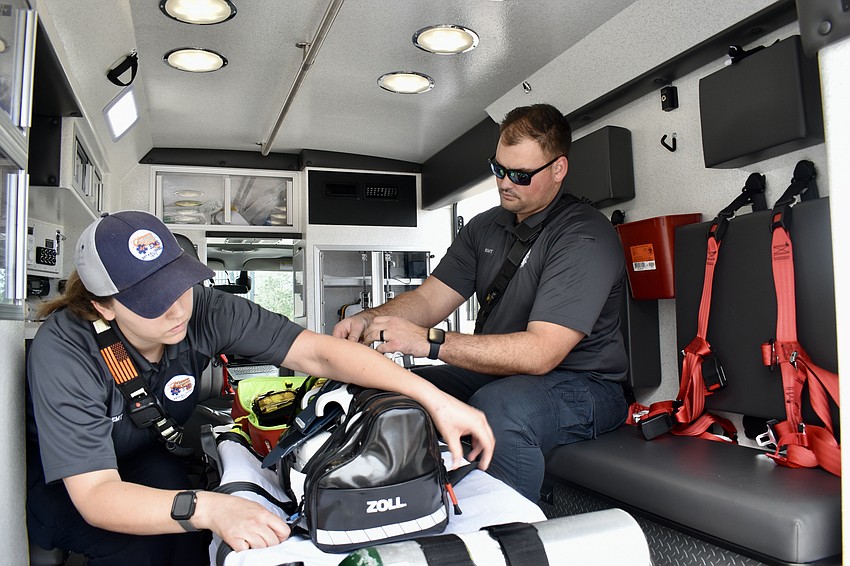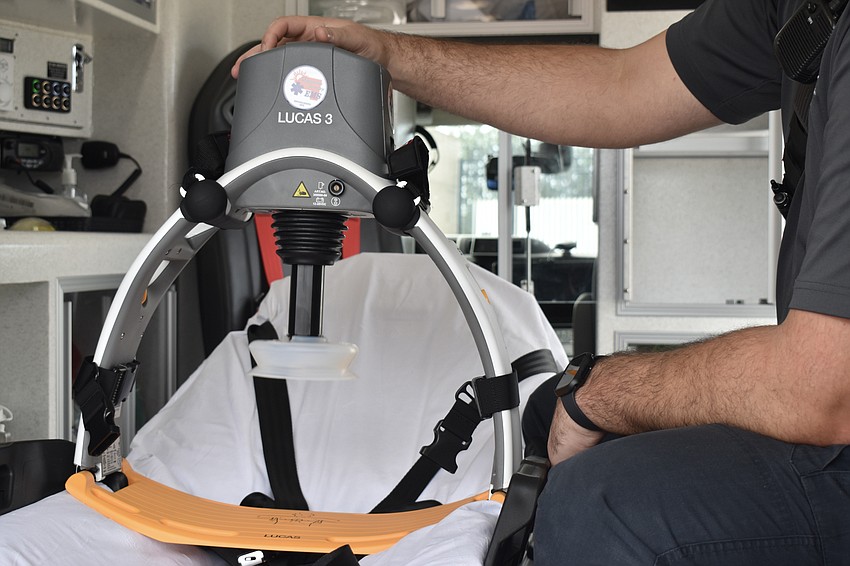- November 23, 2024
-
-
Loading

Loading

Ambulances have been navigating Manatee County roads since the early 1920s when most of them were retrofitted hearses operated by funeral homes.
But that doesn't mean county residents want a classic pulling up to their home in an emergency.
Manatee County commissioners know they have to maintain the most up-to-date equipment and therefore approved in November a request from the county's Fleet Division to purchase six new Braun Chief XL Ford F550 ambulances. The budget for the purchase is $2,450,178, and the ambulances are replacements that will replace aging models.
County representatives say the ambulances, mobile crisis centers stocked with everything from bandages to ballistic kits, will serve the entire county.
“All of these vehicles, regardless of where they start, will move all day long,” EMS Chief James Crutchfield said. “Let’s say when that ambulance off Malachite Drive gets a call, another unit from downtown, midtown or anywhere else in the county will shuffle in closer. It’s like a chess game.”
While the vehicles will be new, the models are the same. Crutchfield said it’s crucial to maintain uniformity to foster muscle memory in the team and minimize errors.
There are 26 ambulances in the fleet and 21 are advanced life support ambulances, and five are basic life support ambulances. The only major difference between the two is that an ALS ambulance can carry medicine.
A new ambulance has an expected life span of five to seven years. When deciding one needs to be replaced, the Fleet Department considers the cost of continued maintenance, how much it can sell for at auction and how much money the county has set aside to replace it.
“We operate a highly reliable fleet. That’s something you want to work 100% of the time,” Crutchfield said. “When a 911 call comes in, you expect it to turn on.”
While flashy features might attract a new car buyer, purchasing an ambulance revolves around safety regulations, storage space and an ergonomic design for first responders who spend up to 12 hours a day driving them.
The interior storage space, located in the back where patients are treated, needs to accommodate cardiac monitors, oxygen delivery systems, airway management tools and medications.
The exterior storage holds bigger equipment that helps get patients down stairs and onto the stretcher. The ballistic kits are kept there, too. They contain bullet proof vests stocked with shears to cut clothing, devices to secure airways, pressurized gauze to stuff wounds and triage tags to prioritize patients during mass casualty events.

“The Zoll monitor is probably our most used piece of equipment,” EMT Rachel Swim said. “It gives us pulse ox (measure of oxygen in blood), blood pressure and heart rate — we have the capability to do four, 12 or 15 leads and then transmit those to the hospital.”
In layman's terms, the Zoll is an ECG monitor. Using more leads provides more information and better imaging of the patient’s heart.
The communication system in the ambulance provides the hospital with real-time assessments of the patient’s condition, so staff is prepared upon arrival. In return, hospital staff can provide guidance to the paramedics and EMTs. In the case of a cardiac patient, hospital staff are reading the ECG results as the ambulance is en route and responding with information about any abnormalities that would change the standard protocol.
There’s a fully functional defibrillator on board that recognizes shockable rhythms for when patients are in cardiac arrest. Manatee County purchased its first defibrillator in 1996.

There’s equipment that assists the paramedics and EMTs, too. CPR is a basic skill for any emergency worker, but it requires both hands and full focus, so the ambulances are equipped with a Lucas device.
“It’s an automated CPR device that sits underneath the patient and compresses for us, allowing us to focus on the airway, breathing and then transporting again and changing priority to the hospital,” Swim said.
Swim and her partner, Jake Stickler, have both been working as EMTs for two years. The majority of calls they get are from falls, which can be quite serious.
“Two weeks ago, it was a ground level fall and turned into a trauma alert,” Stickler said. “We put a C collar (placed around the neck) on a 77-year-old female, and when we rolled her over, her femur went in two different directions.”
After Stickler explained how he and Swim placed a traction splint on her leg and had to use a special scoop stretcher because the patient's opposite hip was unstable, he added what a nice woman she was. He spoke with genuine care and concern that EMS received so many calls on the day she fell that there were no ALS ambulances available, so she had to deal with the pain without medication. Only paramedics can administer drugs. Protocol, though, allows the crew to transport an individual to the nearest medical facility when doing so is quicker than an ALS unit can arrive.
Despite all the sirens, bells and whistles, human interaction is something an ambulance alone can’t provide but is essential to its services.
“What’s truly remarkable is the caliber of individuals who staff these ambulances,” Crutchfield said. “Beyond their medical expertise, they also serve as compassionate counselors, offering support and reassurance during what may be the most challenging moments in people’s lives.”